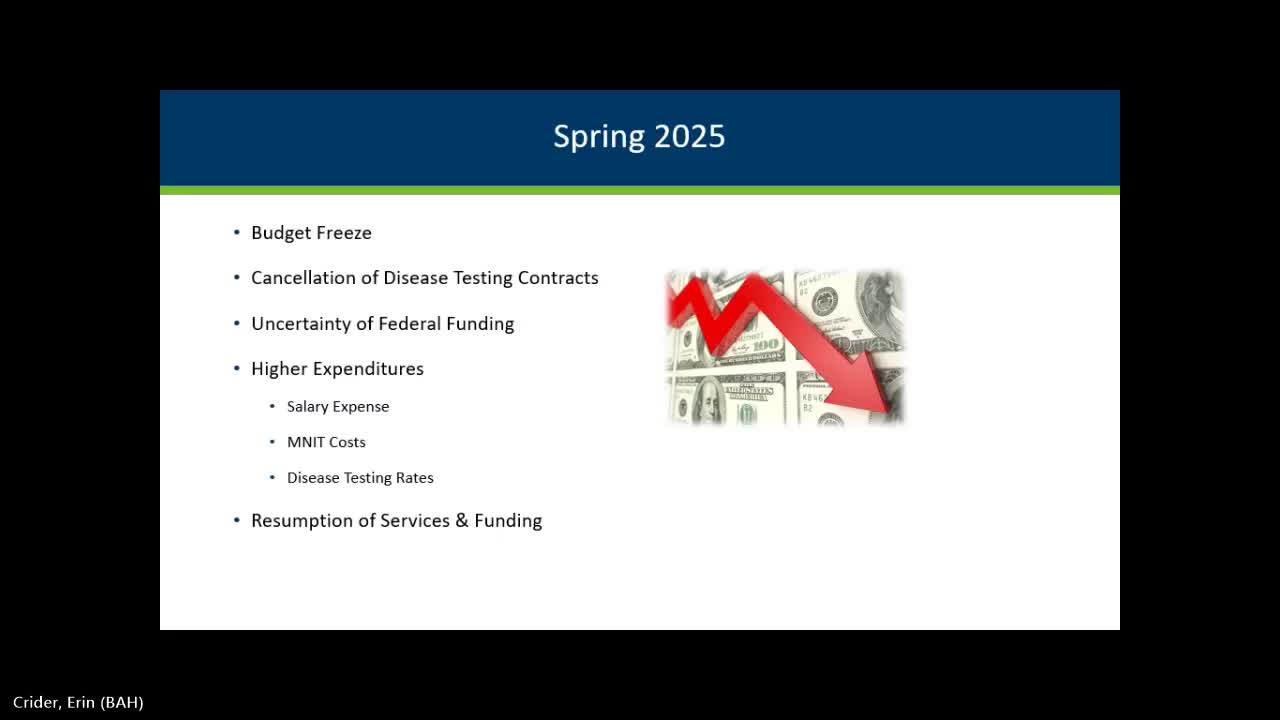Board Secures $8.3M Budget for Fiscal Year 2026 Amid Funding Uncertainty
September 11, 2025 | Board of Animal Health, Agencies, Boards, & Commissions, Executive, Minnesota
This article was created by AI summarizing key points discussed. AI makes mistakes, so for full details and context, please refer to the video of the full meeting. Please report any errors so we can fix them. Report an error »

Budgetary concerns dominated the Minnesota Board of Animal Health's Quarterly Board Meeting on September 11, 2025, as officials navigated the complexities of funding amidst a federal budget freeze. The board's financial outlook for fiscal year 2026 was a key focus, with a general appropriation of $6,675,000 allocated for 2026 and $6,800,000 for 2027, aimed at maintaining current service levels.
The meeting revealed that 73% of the board's budget is earmarked for salaries and payroll, underscoring the ongoing challenge of managing rising personnel costs. Despite securing some funding through legislative sessions, the board faced uncertainties regarding federal support, which led to the cancellation of a disease testing contract earlier in the year. Fortunately, services were resumed in April, allowing for a more stable operational framework.
In addition to salary expenses, the board highlighted significant allocations for professional technical services, which account for 9% of the budget, and information technology costs, which are projected to rise by 11%. The board's commitment to streamlining expenditures was evident, with efforts to reduce costs in areas such as space rental and telecommunications.
Looking ahead, the board is preparing for potential cooperative agreements with the USDA, which could provide additional funding for emergency responses to livestock diseases. However, officials cautioned that while budgets may appear robust, actual expenditures will depend on qualifying needs and circumstances.
As the board continues to adapt to fiscal challenges, the focus remains on ensuring effective service delivery while managing costs effectively. The next steps will involve monitoring budget utilization closely and preparing for the implications of new labor agreements and state mandates, such as the Minnesota paid leave law set to take effect in January 2026.
The meeting revealed that 73% of the board's budget is earmarked for salaries and payroll, underscoring the ongoing challenge of managing rising personnel costs. Despite securing some funding through legislative sessions, the board faced uncertainties regarding federal support, which led to the cancellation of a disease testing contract earlier in the year. Fortunately, services were resumed in April, allowing for a more stable operational framework.
In addition to salary expenses, the board highlighted significant allocations for professional technical services, which account for 9% of the budget, and information technology costs, which are projected to rise by 11%. The board's commitment to streamlining expenditures was evident, with efforts to reduce costs in areas such as space rental and telecommunications.
Looking ahead, the board is preparing for potential cooperative agreements with the USDA, which could provide additional funding for emergency responses to livestock diseases. However, officials cautioned that while budgets may appear robust, actual expenditures will depend on qualifying needs and circumstances.
As the board continues to adapt to fiscal challenges, the focus remains on ensuring effective service delivery while managing costs effectively. The next steps will involve monitoring budget utilization closely and preparing for the implications of new labor agreements and state mandates, such as the Minnesota paid leave law set to take effect in January 2026.
View full meeting
This article is based on a recent meeting—watch the full video and explore the complete transcript for deeper insights into the discussion.
View full meeting
